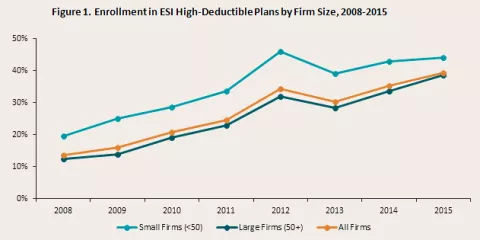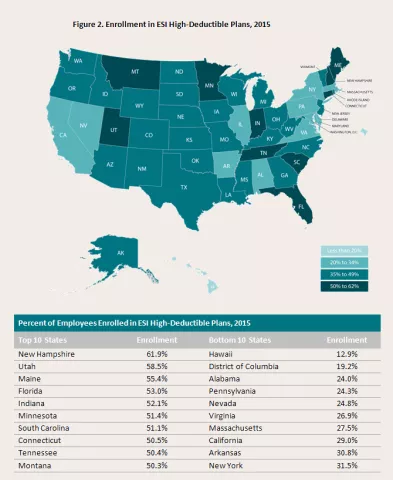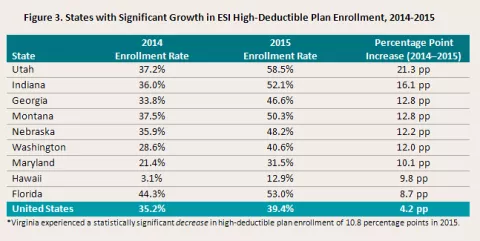With the recent focus on health insurance coverage purchased through Affordable Care Act marketplaces, it is easy to forget that the majority of individuals are enrolled in health insurance through their employer (56% in 2015).[1] This blog is the first in a series that highlights the experiences of individuals enrolled in private sector employer-sponsored insurance. It uses data from the Medical Expenditure Panel Survey-Insurance Component (MEPS-IC) recently collected by the Agency for Healthcare Research and Quality (AHRQ).
What is a high-deductible health plan?
A plan with a deductible requires an upfront payment for medical services before insurance coverage kicks in. For example, if the deductible is set at $500, the individual must pay all of the expenses of any covered medical treatment up to $500. After the deductible has “been met” (i.e., the individual has paid for $500 worth of medical bills), all medical bills greater than the $500 deductible are covered by the health plan.
For the purposes of our analysis, high-deductible plans are defined as plans that meet the minimum deductible amount required for Health Savings Account (HSA) eligibility — $1,300 for an individual and $2,600 for a family in 2015).
Enrollment in high-deductible plans has been increasing steadily.
In 2015, almost 40% of private sector workers were enrolled in a high-deductible plan through their employer (Figure 1). This represents an almost threefold increase between 2008 and 2015. While the growth trend among these plans is similar for large and small firms, workers in small firms have had historically higher enrollment in high-deductible plans.
Enrollment in high-deductible plans varies across the country.
The percent of workers enrolled in employer-sponsored plans with high deductibles varied widely by state in 2015, from 12.9% in Hawaii to 61.9% in New Hampshire. Among firms of all sizes, enrollment in high-deductible plans was at least 50% in ten states and below 30% in just eight states and the District of Columbia in 2015.
Nine states saw significant increases in high-deductible enrollment.
National growth in high-deductible plans between 2014 and 2015 seems to have been driven by a relatively small number of states. While roughly three quarters of the states experienced some increase in the percent of private-sector employees enrolled in high-deductible plans, only nine states saw a statistically significant increase (this represents fewer states with statistically significant increases compared to 2013–2014).
Why are more people enrolling in high-deductible plans?
High-deductible plans have become increasingly popular over recent years because they help to keep premiums affordable, thereby helping get more people covered, and they are meant to provide an incentive for people to (a) use medical care only when they need it and (b) shop around for the care they do use.
The advantage of high-deductible plans is that they tend to have lower premiums — making health insurance more affordable and accessible. Additionally, deductibles do not apply to preventive services — including screenings, immunizations, and an annual physical — which must be provided with no out-of-pocket payment under the Affordable Care Act.
The main disadvantage of high-deductible plans is that the higher deductibles may act as a significant barrier to getting needed care. This can be especially problematic for people with chronic conditions or those facing a medical emergency. Also, while deductibles do not apply to preventive services as defined by the Affordable Care Act, there may be confusion about this among high-deductible plan enrollees who may unnecessarily forgo preventive care due to cost concerns. In addition, it can be difficult to understand what payments are eligible to contribute toward one's deductible. In most cases, payments for services provided by out-of-network providers or for non-covered benefits (e.g., vision, dental, over-the-counter medicines, brand name prescriptions, etc.) do not count toward the deductible. Finally, hospitals and other providers have raised concerns about the difficulty of collecting the required out-of-pocket payments at the point of service, a challenge that can contribute to bad medical debt.
Notes: This analysis focuses on private sector workers. Small firms are defined as having fewer than 50 employees, and large firms are defined as having 50 or more employees. High-Deductible Plans are defined as plans that meet the minimum deductible amount required for Health Savings Account (HSA) eligibility (i.e., $1,300 for an individual and $2,600 for a family in 2015). Findings are based on SHADAC analysis of the Medical Expenditure Panel Survey - Insurance Component. Changes are statistically significant at the 95 percent confidence level.
[1] Barnett, J.C., & Vornovitsky, M. September 13, 2016. “Health Insurance Coverage in the United States: 2015.” Current Population Reports. Washington, DC: U.S. Census Bureau. Available at http://www.census.gov/content/dam/Census/library/publications/2016/demo/p60-257.pdf



